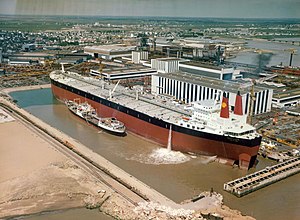Batillus class supertankers

The oil tanker Batillus at the end of her construction in Saint-Nazaire, being fueled by Port-Vendres
|
|
| Class overview | |
|---|---|
| Name: | Batillus class |
| Operators: |
|
| In service: | 1976 to 2003 |
| Completed: | 4 |
| Retired: | 4 |
| General characteristics | |
| Type: | Supertanker |
| Tonnage: | |
| Displacement: |
|
| Length: |
LOA: 414.22 m (1,359.0 ft) LBP: 401.10 m (1,315.9 ft) |
| Beam: | 63.01 m (206.7 ft) |
| Draft: | 28.5 m (94 ft) |
| Depth: | 35.92 m (117.8 ft) |
| Installed power: | 64,800 bhp (48.3 MW) |
| Propulsion: |
|
| Speed: | 16 kn (30 km/h; 18 mph) |
| Notes: | |
LOA: 414.22 m (1,359.0 ft)
The Batillus-class supertanker was a class of tanker ships built in France at the end of the 1970s. Four such ships were built between 1976 and 1979—serving until the final one was scrapped in 2003. They were built in the Bassin C dock of the Chantiers de l'Atlantique shipyards at Saint Nazaire, France. Measured by gross tonnage, these were, at the time, the largest ships of any type ever constructed.
While being the largest ships ever built by gross tonnage until Pioneering Spirit, the four Batillus class ships were the second largest ever constructed when measuring deadweight tonnage or length overall, behind only the supertanker Seawise Giant (renamed four times, including Knock Nevis), which existed from 1979 to 2009.
While there were minor differences between the four Batillus class ships, they all approached 275,000 tonnes gross (GT) tonnage, 555,000 tonnes deadweight (DWT) tonnage, and had a length overall of just over 414 metres (longer than all but a few of the tallest skyscrapers in the world).
The Batillus class depth of nearly 36 metres from the main deck and a full load draft of 28.5 metres are records for ships of any kind, being slightly greater than the two Globtik Tokyo class ULCCs.
Unlike Seawise Giant and most other ULCCs, the Batillus class vessels had twin screws, twin boilers of full size and power, and twin rudders. As a result, in an emergency they could more easily and safely be operated than with a single propeller and a single boiler.
...
Wikipedia
